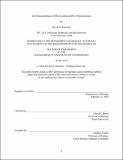The structural basis of RNA-catalyzed RNA polymerization
Author(s)
Shechner, David M
DownloadFull printable version (112.2Mb)
Other Contributors
Massachusetts Institute of Technology. Dept. of Biology.
Advisor
David P. Bartel.
Terms of use
Metadata
Show full item recordAbstract
The Class I ligase is an artificial ribozyme that catalyzes a reaction chemically identical to a single turnover of RNA-dependent RNA polymerization. Such an activity would have been requisite for the emergence of a self-replicase ribozyme, an enzyme that, according to the RNA World hypothesis, would be fundamental for the emergence of life. Demonstrating the plausibility of RNA-catalyzed self-replication, the Class I ligase catalytic machinery was previously harnessed to produce general RNA polymerase ribozymes. Hence, this ligase represents a robust model system for studying both the potential role RNA may have played in the origins of life and RNA catalysis in general. Through a combination of crystallographic and biochemical experiments, we have sought to elucidate the structure and mechanism of this ribozyme. As a starting point for our experiments, the crystal structure of the self-ligated product was solved to 3.0 Angstrom resolution, revealing a tripodal architecture in which three helical domains converge in the vicinity of the ligation junction. A handful of tertiary interactions decorate this tripod scaffold; among them were two instances of a novel motif, the A-minor triad. The structure elucidated interactions that recognize and bind the primer-template duplex and those that position the reaction electrophile. It furthermore revealed functional groups that compose the active site. Biochemical evidence and the position of these groups lead us to propose a reaction mechanism similar to that used by proteinaceous polymerases. Using a slowly reacting mutant, 3.05-3.15 Angstrom crystal structures were solved of unreacted, kinetically trapped ligase-substrate complexes bound to different metal ions. Comparison of the Ca2+- and Mg2+-bound structures explains the preference of the ligase for Mg 2+. Moreover, these structures revealed features missing in the product structure: interactions to the 5'-triphosphate and an active site catalytic metal ion. While this metal is positioned in a manner similar to the canonical "Metal A" of proteinaceous polymerases, the role of "Metal B" might have been supplanted by functional groups on the RNA. Kinetic isotope experiments and atomic mutagenesis of two active site functional groups imply that they may act in concert to electrostatically aid transition-state stabilization.
Description
Thesis (Ph. D.)--Massachusetts Institute of Technology, Dept. of Biology, 2010. Cataloged from PDF version of thesis. Includes bibliographical references.
Date issued
2010Department
Massachusetts Institute of Technology. Department of BiologyPublisher
Massachusetts Institute of Technology
Keywords
Biology.